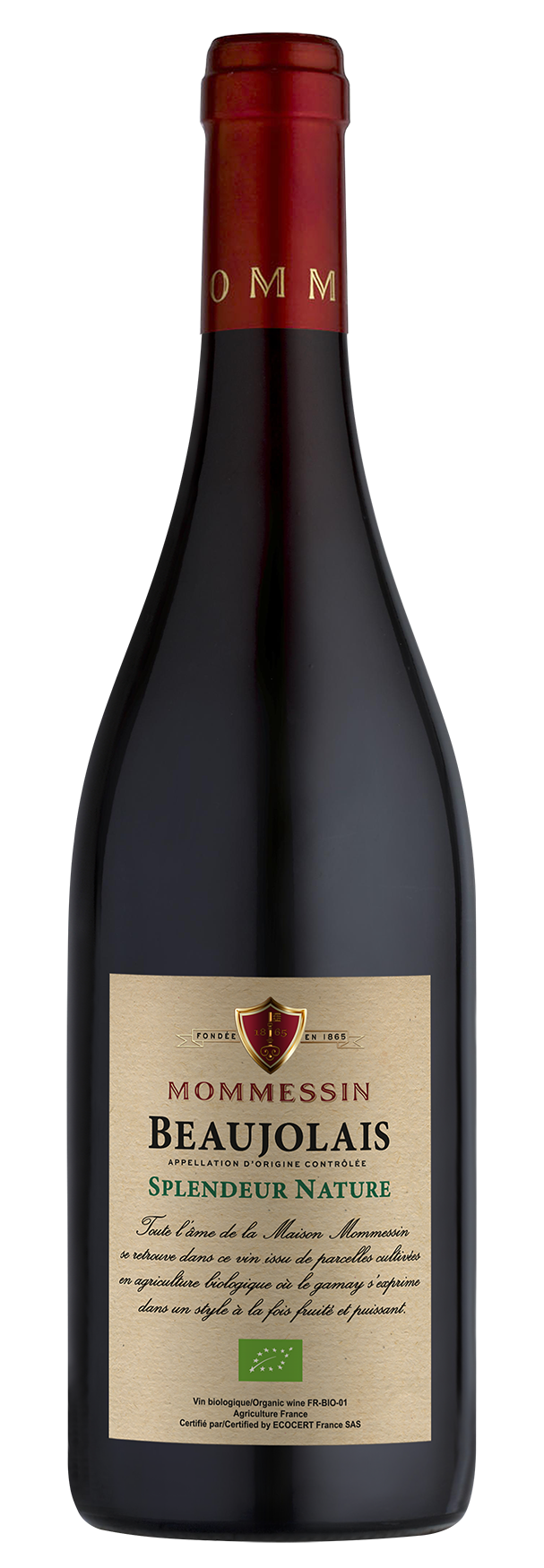BEAUJOLAIS BIO 2023
Grape varietal
100% Gamay.
Tasting notes
Colour: Beautiful, intense ruby colour.
Nose: The bouquet is equally intense, offering subtle, varied aromas of red fruit.
Palate: A fine, elegant wine that reveals a wide range of crisp fruit flavours and tremendous freshness.
Serving suggestions
Serve at a temperature of 13-14°C. (55-57°F).
Food and wine pairing
May be enjoyed simply as an aperitif, accompanied by a selection of local charcuterie or a home-made country terrine, or during a meal, accompanied by white meat, grilled food, vegetarian cuisine, savoury tarts, pasta dishes or a lightly seasoned pizza. It also goes very well with mature cheeses.
Ageing potential
Already very pleasant, this Beaujolais can easily be cellared for up to five years.
Origins
The Beaujolais appellation essentially groups together wines from the region located south of Villefranche-sur-Saône. The vineyards vary enormously, extending over 9,700 hectares overlooking the Saône plain between Mâcon and Lyon and bordered to the west by the foothills of the Massif Central.
Terroir
Our wine is made from organically grown Gamay grapes from three different plots.
Two of these consist of mainly hard limestone soil and marl slopes covered with scree with some rows of vines planted on residual clay with pieces of chert.
The vines on the third plot are planted mainly on granite with some on siliceous volcanic rock and on schist or bluish rock.
Vine and soil
- Planting density: 8,000-10,000 vines/ha
- Average age of the vines: 45 years old.
- Yield: 30hl/ha.
- Pruning: Cordon or Single Guyot.
- Vineyard management: organic agriculture.
Everything is carefully analysed: the threat of diseases, the numbers of insect pests and auxiliaries present in the plots’ agro-system, the size and number of bunches, the effect of weeds, the state of the vines’ foliage, etc.
Soil management: decavaillonnage (turning over the soil around the base of each vine), light ploughing, work between the vines.
This approach meets two objectives:
- restoring the physiological balance of the vines, the soil and the terroir,
- protection and respect of the environment.
Vinification and maturing
The Gamay grapes were sorted out in the vineyard and then, once again, at the arrival at the winery. Most of the grapes were destemmed and macerated for 8-10 days.
There are also wines produced in the traditional Beaujolais style in the blend, with semi-carbonic maceration from 5 to 8 days. This wine was aged on fine lees in stainless steel and concrete vats.
Vintage : 2023
The first harvest began on September 4th. Despite a period of scorching heat, the grapes are superb, promising an exceptional vintage.
The intense heat at the end of August accelerated the maturation of our Gamay. This vintage is characterized by great heterogeneity between the plots. Some struggled with the extreme conditions, losing a lot of juice, while others resisted admirably. Several factors explain these variations: soil type, exposure, vine age, and yield. The differences between early and late-ripening zones are minimal, reflected in the variability of the analytical data from one cuvée to another, with potential alcohol levels ranging from 12° to 14°. Although we anticipated a bountiful harvest in the spring, we are seeing a significant reduction in volumes. The berries have thick skins and reveal aromas of raspberry liqueur, cherry, as well as notes of violet, dark chocolate, and even pear!
The musts have a high sugar concentration and marked acidity. This year, we favored destemming to prolong the maceration of our Gamays. In addition to the traditional whole cluster semi-carbonic maceration, we opted for hot pre-fermentation maceration to maximize color extraction from the grapes most affected by the drought.
Awards
- February 2025 : Silver Medal - CONCOURS DES GRANDS VINS DU BEAUJOLAIS




